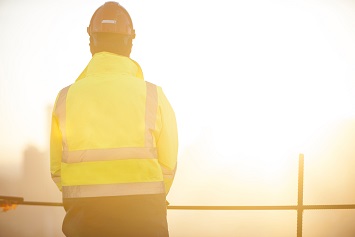Workers’ health and safety are increasingly at risk due to the impacts of climate change that include excessive heat, extreme weather, increasing air and water pollution, and infectious diseases, according to a new report issued July 28 by the Natural Resources Defense Council (NRDC).
“Climate change is already making existing workplace hazards worse and creating new ones, and the situation will only accelerate as our world gets even hotter and our weather more extreme,” according to “On the Front Lines: Climate Change Threatens the Health of America’s Workers,” a report issued by the NRDC and the BlueGreen Alliance of environmental and labor organizations.
Climate change poses a serious health threat to people working at indoor jobs, such as airline flight attendants, home healthcare workers, teachers, and warehouse workers, as well as outdoor workers, the report said.
The COVID-19 pandemic is adding another layer of danger for essential workers because many also are threatened by climate change, according to the NRDC. The group said that workers facing risks from both climate change and COVID-19 include wildland firefighters, public health nurses conducting outdoor COVID-19 tests, migrant workers engaged in flood and hurricane recovery, and teachers who may have to return to schools lacking air conditioning.
“The climate crisis isn’t just endangering the health and safety of outdoor workers, it’s also a serious threat to indoor workers. Janitors, bus drivers, public health workers, and others deemed essential in the pandemic, are on the frontlines of harm,” Juanita Constible, principal author of the report and a climate health expert at the NRDC, said in a statement.
The NRDC also said that black people, Latino, and other people of color who are experiencing the highest numbers of deaths from COVID-19 are more likely to work in essential industries and jobs than white people.
The report includes 14 firsthand case studies of outdoor and indoor workers impacted by climate change.
The report called for a number of legislative, regulatory, and enforcement actions protect workers, including:
- Strengthening the role of unions and other worker organizations to ensure workers are full partners in the effort to protect their health and safety from climate change;
- Building a better system to track, analyze, and act on existing and emerging health and safety threats to workers;
- Amending the Occupational Safety and Health Act to ensure state and local public sector workers are protected in all 50 states, the District of Columbia, and all island territories;
- Ensuring the Occupational Safety and Health Administration (OSHA) has enough budget and staffing for timely and effective enforcement;
- Creating policies and programs to help professionalize disaster response and recovery across multiple sectors, including through job creation and training programs and climate information support for labor unions and employers;
- Developing plans at the Department of Labor to address the cumulative health and safety threats of climate change to workers; and
- Establishing an enforceable federal OSHA heat health standard protecting all workers.

